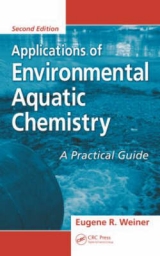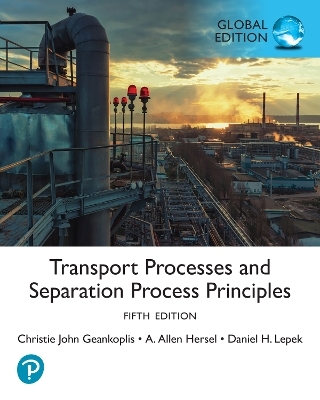
Applications of Environmental Chemistry
Lewis Publishers,U.S. (Verlag)
978-1-56670-354-3 (ISBN)
- Titel erscheint in neuer Auflage
- Artikel merken
Up until the 1950s, waste disposal meant discharging it to the nearest river, burning it up or shipping it out to sea. Now we are paying the price. Current disposal and cleanup regulations have a different focus: correcting the problems caused by earlier misguided attitudes and maintaining a non-degrading environment. State and Federal clean air and water acts have created the need to identify and measure chemical components that affect the quality of surface and ground waters and the soils through which they flow.
The easy-to-use structure of this book makes it a handy resource. The author summarizes the chemistry topics most important in environmental applications. He includes frequently used data such as: water solubilities, partition coefficients, natural abundance of trace metals in soil, and federal drinking water standards. Lists containing "rules of thumb" supply methods for making quick estimations.
Applications of Environmental Chemistry provides the basic equations, theories, and principles you need to understand - at a practical level - frequently encountered topics in environmental chemistry. It does not overwhelm you with excess information but answers your most frequently asked questions clearly and succinctly.
Water Quality
Defining Water Quality
Sources of Water Impurities
Measuring Impurities
Principles Of Contaminant Behavior in the Environment
The Behavior of Contaminants in Natural Waters
What are the Fates of Different Pollutants?
Processes that Remove Pollutants from Water
Major Contaminant Groups and Their Natural Pathways for Removal from Water
Chemical and Physical Reactions in the Water Environment
Partitioning Behavior of Pollutants
Intermolecular Forces
Predicting Bond Type from Electronegativities
Molecular Geometry, Molecular Polarity, and Intermolecular Forces
Solubility and Intermolecular Attractions
Major Water Quality Parameters
Interactions Among Water Quality Parameters
pH
Oxidation-Reduction Potential (Redox Potential)
Carbon Dioxide, Bicarbonate, and Carbonate
Acidity and Alkalinity
Hardness
Dissolved Oxygen (DO)
Biological Oxygen Demand (BOD) and Chemical Oxygen Demand (COD)
Nitrogen: Ammonia (NH3), Nitrite (NO2-), and Nitrate (NO3-)
Sulfide (S-2)
Phosphorus (P)
Metals in Water
Solids (Total, Suspended, and Dissolved)
Temperature
Soil, Groundwater, and Subsurface Contamination
The Nature of Soils
Soil Profiles
Organic Matter in Soil
Soil Zones
Contaminants Become Distributed in Water, Soil, and Air
Partition Coefficients
Mobility of Contaminants in the Subsurface
Particulate Transport in Groundwater: Colloids
Biodegradation
Biodegradation Processes
California Study
Determining the Extent of Bioremediation of LNAPLs
Petroleum Releases to the Subsurface
The Problem
General Characteristics of Petroleum
Behavior of Fuel Hydrocarbons in the Subsurface
Petroleum Mobility and Solubility
Formation of Petroleum Contamination Plumes
Estimating the Amount of Free Product in the Subsurface
Estimating the Amount of Residual LNAPL Immobilized in the Subsurface
DNAPL Free Product Plume
Chemical Fingerprinting
Selected Topics in Environmental Chemistry
Acid Mine Drainage
Agricultural Water Quality
Breakpoint Chlorination for Removing Ammonia
De-Icing and Sanding of Roads: Controlling Environmental Effects
Drinking Water Treatment
Ion Exchange
Indicators of Feed Contamination: Coliform and Streptococci Bacteria
Municipal Wastewater Reuse: The Movement and Fate of Microbial Pathogens
Odors of Biological Origin in Water
Quality Assurance and Quality Control (QA/QC) in Environmental Sampling
Sodium Adsorption Ratio (SAR)
Oil and Grease
A Dictionary Inorganic Water Quality Parameters and Pollutants
Introduction
Alphabetical Listing of Inorganic Water Quality Parameters and Pollutants
Appendix A: Drinking Water
Appendix B: National Recommended Water Quality Criteria
Appendix C: Sampling Containers, Minimum Sample Size, Preservation Procedures, and Storage Times
| Erscheint lt. Verlag | 26.5.2000 |
|---|---|
| Zusatzinfo | 196 equations; 7 Halftones, black and white; 40 Tables, black and white |
| Verlagsort | London |
| Sprache | englisch |
| Maße | 178 x 254 mm |
| Gewicht | 680 g |
| Einbandart | gebunden |
| Themenwelt | Technik ► Umwelttechnik / Biotechnologie |
| ISBN-10 | 1-56670-354-9 / 1566703549 |
| ISBN-13 | 978-1-56670-354-3 / 9781566703543 |
| Zustand | Neuware |
| Informationen gemäß Produktsicherheitsverordnung (GPSR) | |
| Haben Sie eine Frage zum Produkt? |
aus dem Bereich



